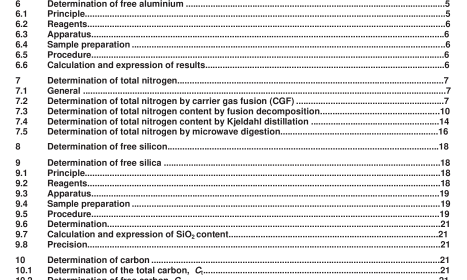BS EN 12698-1:2007 – Chemical analysis of nitride bonded silicon carbide refractories — Part 1: Chemical methods

1 Scope
This standard describes the methods for the analysis of all refractory products containing nitride and oxynitride bonded silicon carbide, irrespective of the silicon carbide level. It includes details of sample preparation, general principles of chemical analysis and detailed methods for the determination of carbon,silicon carbide, free aluminium, free silicon, total nitrogen and oxygen.
2 Normative references
The following referenced documents are indispensable for the application of this document. For dated references, only the edition cited applies. For undated references, the latest edition of the referenced document (including any amendments) applies.
EN 1 2475-4:1 998, Classification of dense shaped refractory products — Part:4 Special products
EN 1 2698-2, Chemical analysis of nitride bonded silicon carbide refractories — Part 2: XRD methods prEN ISO 21 068, Chemical analysis of silicon carbide containing raw materials and refractory products
ISO 836:2001 , Terminology for refractories
ISO 331 0-1 , Test sieves — Technical requirements and testing — Part 1: Test sieves of metal wire cloth
ISO 5022, Shaped refractory products — Sampling and acceptance testing
ISO 5725-1 , Accuracy (trueness and precision) of measurement methods and results — Part 1: General principles and definitions
ISO 8656-1 , Refractory products — Sampling of raw materials and unshaped products — Part 1:Sampling scheme
3 Terms and Definitions
For the purposes of this document the terms and definitions given in ISO 836:2001 , EN 1 2475-4:1 998 and the following apply.
3.1
nitride and oxynitride bonded silicon carbide refractories
refractory products predominantly consisting of silicon carbide with minor amounts of nitride phases as a matrix component
NOTE In general, metallic silicon is used as precursor material which undergoes a phase transformation in an oxygen-free nitrogen atmosphere.
4 Methods for determination
A list of methods and the relevant European Standards are given in Table 1 .
Carbon is determined by the evolution of carbon dioxide on combustion in a stream of oxygen at defined
temperatures. Silicon carbide is calculated by the difference of total carbon (C total ) and free carbon (C free ).
NOTE 1 The carbon dioxide evolved can be conveniently measured coulometrically, gravimetrically by absorbtion onto soda lime, or by infrared detection.
Free aluminium is determined by the evolution of hydrogen on treatment with hydrochloric acid and by measuring the gas volume in a nitrometer. Free silicon shall be determined on the same sample by treatment with sodium hydroxide.
Total nitrogen is determined by a variety of methods: carrier gas fusion, alkaline fusion, Kjeldal distillation or microwave digestion.
NOTE 2 The nitrogen can be conveniently measured by thermal conductivity or after digestion as ammonium by titration with hydrochloric acid. Distinction between aluminium nitride and silicon nitride is made by their reaction with sodium hydroxide solution; aluminium nitride is quantitatively decomposed yielding free ammonia, while silicon nitride is unaffected.
BS EN 12698-1:2007 – Chemical analysis of nitride bonded silicon carbide refractories — Part 1: Chemical methods